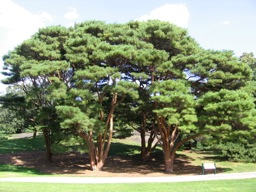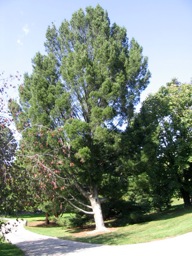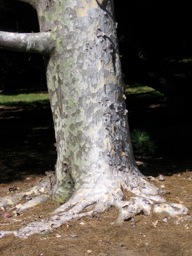Rare Specimens: The Ross Conifer Collection
Posted in Around the Garden, Gardens and Collections on November 16 2011, by Joyce Newman

The Arthur and Janet Ross Conifer Arboretum at The New York Botanical Garden covers nearly 40 acres of rolling landscape in the heart of the garden. It became the first collection of living plants at the Garden with plantings started in 1901, and now boasts more than 250 mature conifers, some of which are more than 100 years old.
Some of the earliest conifers to arrive at the garden–planted in 1908–are the Tanyosho pines, conifers that display a beautiful, orange-red bark with branches that can often be seen spreading in an umbrella shape. Our grove of five mature specimens is a very unique example of the species in the U.S., especially when considering that each tree is more than a century old.
Did you know that globally, boreal conifer forests cover more land mass than any other type of forest on the planet? In fact, they take up more space than all of the tropical rain forests combined. This makes conifers an extremely important family of trees, not to mention record-holders for the world’s oldest, tallest, and most massive trees.

But what exactly is a conifer? Conifers are cone-bearing trees–on the Tanyosho pine you can see small, egg-shaped cones, while the recognizable needles are straight and grow in clusters of two. In turn, other conifers have different types of needles and cone shapes. They include pines, spruces, and firs.
And did you know that the redwoods of California are conifers, as well as the pitch pines in southern New Jersey’s Pine Barrens? The junipers along highways and lovely smelling balsam firs in New Hampshire’s White Mountains are, as well. Without a doubt, conifers are a very diverse family of trees beyond what you see covered in lights during the holidays.
Conifers are often contrasted with deciduous trees, which lose their leaves, whereas conifers’ leaves–usually called needles–are, with few exceptions, evergreen. Needles can remain on most conifers for up to 30 years.
A few steps over to the right of the Tanyosho pines, you can see a very different conifer called the lacebark pine. This tree is revered in China, where it is native and planted in temple courtyards and sacred sites. The NYBG received this specimen as a sapling sent from the USDA Plant Introduction Program in 1909.

As the tree matured, its trunk and bark became increasingly white, and the patches of greens, grays, and tans on the bark changed dramatically. Now a very mature specimen–more than 100 years old–its ghostly white bark has an ethereal aura. Sadly, while the lacebark pine has been planted in China for centuries, it is becoming rare in the wild and is now threatened with extinction. This makes our specimen a truly special treasure.
With winter approaching and the deciduous trees shedding their leaves, now is the perfect time to visit the Garden’s Ross Conifer Arboretum and view the evergreens, both those mentioned here and many more.

